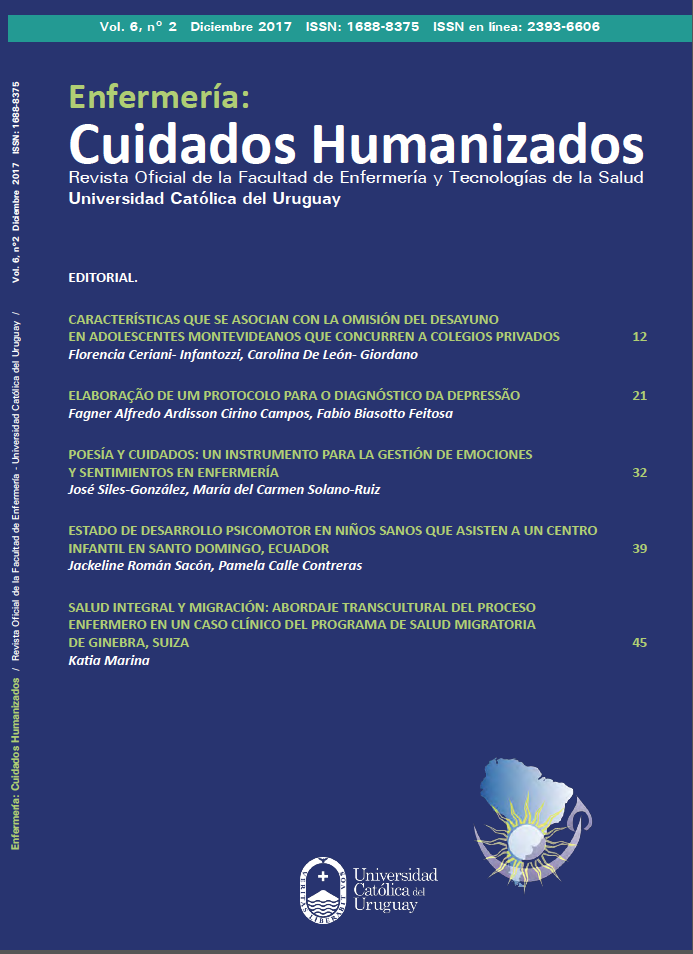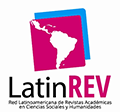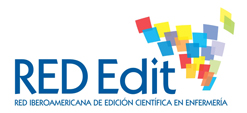PSYCHOMOTOR DEVELOPMENT STATUS IN HEALTHY CHILDREN ATTENDING A CHILD CENTER IN SANTO DOMINGO, ECUADOR
DOI:
https://doi.org/10.22235/ech.v6i2.1467Keywords:
Child Develpoment, Physical Stimulation, Psychomotor PerformanceAbstract
The goal of this article is to describe psychomotor development scores in children who attend the children's center through Form 028, corresponding to the Internationally Standardized Denver II Test. This is a study with a quantitative approach of descriptive-transversal character. A total of 42 children aged 18-36 months were recruited to attend the Denver II test in Santo Domingo de los Tsáchilas Children's Center in Ecuador. Children with severe pathologies with impediment to answer the form due to deficiency in their physical and mental capacity were excluded. Through the scores obtained by the application of the Denver test, it was observed that the deficit in the Personal-Social Area occurs more in boys (20%) than in girls (5%). In the Fine Motor Skill Area, the deficit occurs in both boys (10%) and girls (9%). In the Language Area it was observed that there is a significant retardation: it was more present in boys (35%) than in girls (18%). It was also observed that the deficit in the Gross Motor Area is higher in boys (15%) than in girls (5%). It is significant the high frequency of deficits shown in psychomotor development in the population evaluated, especially in the language area. Early stimulation and parenting patterns are recommended to improve language development and the performance of children in other areas.
Downloads
References
2. Pando, M., Aranda, C., Amezcua, M., Salazar, J., Torres, T. (2004). Estimulación temprana en niños de 4 años de familias marginadas. Recuperado el 13 enero 2017 de http://www.medigraphic.com/pdfs/pediat/sp-2004/sp046c.pdf
3. Organización Mundial de Salud. Desarrollo [Internet]. [Citado 23 Oct 2016] Disponible en: http://www.who.int/maternal_child_adolescent/topics/child/development/es
4. American Academy of Pediatrics Committee on Children with Disabilities: The pediatrician's role in development and implementation of an Individual Education Plan (IEP) and/or an Individual Family Service Plan (IFSP). Pediatrics 1999; 104: 124-7. [Internet]. [Citado 24 Oct 2016] Disponible en: http://www.scielo.cl/scielo.php?script=sci_nlinks&ref=6856707&pid=S0370-4106201000050000200001&lng=es
5. Moran Aguilar, V., & Robles, A. L. M. Proceso de enfermería. Uso de lenguajes NANDA, NIC y NOC. Modelos referenciales. México, D.F. : Editorial Trillas; 2010.
6. AEPNYA. Protocolo del niño sano. [Internet]. [Citado 26 Nov 2016]. Disponible en: https://www.aeped.es/sites/default/files/documentos/nino_sano_0-2_anos.pdf
7. Medina, A. La estimulación temprana disponible (2002). Recuperado el 13 enero 2017 de http://www.medigraphic.com/pdfs/fisica/mf-2002/mf02-2_4i.pdf
Madrona, P. G., Contreras Jordán, O. R,. Gómez Barreto, I. Habilidades motrices en la infancia y su desarrollo desde una actividad física animada. RIE [Internet]. 2008. [Citado 20 Nov 2016]; 47 Disponible en: http://rieoei.org/rie47a04.htm
8. Coutiño, LB. Desarrollo psicomotriz. Rev Mex Med Fis Rehab 2002; 14 (2-4)
Universidad Politécnica de Madrid. PINEF. Desarrollo motor. [Internet]. 2014 [Citado 20 Nov 2016] Disponible en: http://futbolcarrasco.com/wp-content/uploads/2014/08/futbolcarrascoinef2curso7.pdf
9. Cancho Candela, R.. Desarrollo psicomotor del Niño. [Internet]. 2015 [Citado 20 Nov 2016] Disponible en: Disponible en: http://ceipgarciaquintana.centros.educa.jcyl.es/sitio/upload/DESARROLLO_PSICOMOTOR_I.pdf
Pérez, R. Desarrollo Psicomotor en la Infancia. Madrid: Ideaspropias; 2015.
Maganto, C. Desarrollo físico y psicomotriz en la etapa infantil. [Internet]. 2015. [Citado 3 Ene 2017]; Disponible en: http://webcache.googleusercontent.com/search?q=cache:S9TUwjNZo-oJ:www.sc.ehu.es/ptwmamac/Capi_libro/38c.pdf+&cd=1&hl=es&ct=clnk&gl=ec
Penton Hernández, B. (2015). Motricidad fina en la etapa infantil. Disponible en: http://webcache.googleusercontent.com/search?q=cache:VN5k5LcPepsJ:ardilladigital.com/DOCUMENTOS/EDUCACION%2520ESPECIAL/PSICOMOTRICIDAD%2520-%2520FISIOTERAPIA/CUALIDADES%2520MOTRICES/Motricidad%2520fina%2520en%2520la%2520etapa%2520infantil%2520-%2520Penton%2520-%2520art.pdf+&cd=1&hl=es&ct=clnk&gl=ec
10. Moreno, J. El aprendizaje en el juego motriz en la infancia. Facultad de Educación Universidad de Murcia. [Internet]. 2013. [Citado 3 Ene 2017]; Disponible en: http://webcache.googleusercontent.com/search?q=cache:lwWBVGdXr9UJ:www.um.es/univefd/juegoinf.pdf+&cd=1&hl=es&ct=clnk&gl=ec
Ministerio de Salud Pública. (2015). Instrumento para el llenado del Formulario 028 Test de Denver II. MSP: Quito; Ecuador
11. Puente, E. Relación existente entre el estado nutricional y el desarrollo psicomotriz de los niños de 4 a 5 años de la escuela Santiago Cantos Cordero (Tesis Doctoral). Escuela Politécnica del Ejército. Quito, Ecuador). Recuperado el 7 de noviembre del 2016 de, http://repositorio.espe.edu.ec/bitstream/21000/5427/1/T-ESPE-033358.pdf
12. Ternera, L. A. C. Relación entre el desarrollo personal social y los procesos evolutivos vinculados con el aprendizaje escolar en las áreas del lenguaje y la cognición. Psicogente, [Internet]. 2010. [Citado 3 Ene 2017]; 13(10). Disponible en: http://publicaciones.unisimonbolivar.edu.co/rdigital/ojs/index.php/psicogente/article/view/449/446
Downloads
Published
How to Cite
Issue
Section
License
Copyright (c) 2017 Enfermería: Cuidados Humanizados

This work is licensed under a Creative Commons Attribution 4.0 International License.

















